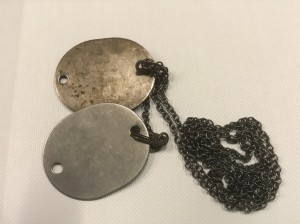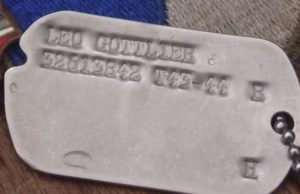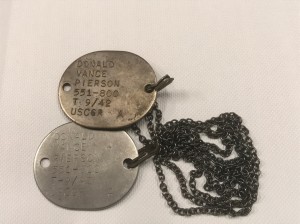What’s in a Collection? Dog Tags
Personal identification tags or commonly referred to as dog tags are an object that most of us are familiar with maybe seeing them in movies or first hand from a family member. They were issued as part of the military uniform, but continued to serve as personal keepsake for family members. The tags primary function was to be used for the identification of fallen and wounded soldiers. These tags varied through time in style, but always had personal information about the individual. However, the history of military identification tags is quite old, and not unique to United States. The Imperial Roman army utilized identification tags for legionaries. In the Roman army, recruits would enter into service starting off in a training phase similar to what we would consider boot camp. If a potential soldier passed all the physical and medical requirements, they were presented with an object called a signaculum. The signaculum was a pendant-like object made out of lead and was to be worn around their neck. The signaculum would have their name etched on it as well as other information like legion they belonged to and start date of service. At the same time they were presented with this, they also were to swear a military oath of service.
In the United States, forms of military personal identification can be traced to the Civil War. Soldiers started pinning tags inside coats with important information about themselves. At the time, badge manufactures attempted to meet this need. They would sell pins with the soldiers name and unit engraved on it, and even made proposals to the US government to provide uniform identification discs. It was not until the early 20th century that the army recognized the importance and began to issue personal identification tags. During World War I dual tags were issued for field combat with additional information that included a serial number, name and occasional medical alerts stamped on the tag.
In our collection we have a set of dog tags from the Pierson collection dating from World War II. This set, as seen in the images, is more oval in shape and might not be what first comes to mind as military identification tag. During the latter part of WWII, these tags were made of brass or stainless steel. Prior to this, a specialized metal (referred to as Monel) high in nickel content was used. In first half of the 20th century some branches of the military only issued dog tags during times of war. It was not until the latter half that they became standard issue. During WWII the US Navy, as well as the US Coast Guard, made this a standard issue item. They also made additions to the type of information recorded. This identification tag would include the individual’s name, service number and branch of service. As we look at this tag, Mr. Pierson was in the US Coast Guard Reserve (USGGR). They also included pertinent medical information that could obviously be very important in a combat situation. As seen in the image, the tag included blood type information and if the person had been vaccinated for tetanus (show by the “T”) as well as when they received that tetanus shot (in this case September 1942). Since there was not a standard set for all branches of the armed service during the war; the tags and information would vary, for instance, the USN would also include a fingerprint that was etched on the reverse side of each tag. Etching the fingerprint was an interesting process involving ink, fine mineral powder, heating the tag, and a final stage that included a bath in acids and water. Putting fingerprints on tags was discontinued during the war, one can image this extensive process could have been part of the reason.
A set of USCGR issued dog tags that belonged to Donald Pierson

Reverse side of the USCGR dog tags
Another interesting aspect with some identification tags was their use with field paperwork. During World War II the US Army issued more rectangular shaped tags that featured a notch at one end. These dog tags were unitized in the field with a device referred to as an Addressograph Model 70. This addressograph was a hand held device that imprinted information from the dog tag onto documents. The device had a rubber pad and a ribbon so that the imprinted information from the tag could be transferred to paperwork. Think of it like a label maker meets the early carbon copy credit card devices. The notch on the tag ensured properly alignment when used with the addressograph. The idea was that the tag could be used for paperwork reducing the potential for error. These types of addressographs were primarily used by the medical departments. The success of these devices was relatively short-lived and limited as field conditions (particularly dirt) caused problems with their usage.

An example of a WWII Army issued dog tag with notch
By the late 1950s, the US military made consistent identification tags a standard issue for all armed services. Though these objects are small they very fascinating for some, their durable construction and other attributes lead to the eventually transformation into a fashion accessory for civilians. These historical artifacts served an important function for the military operations and service, however, they continued to function as symbols of the fallen, and remembrance of the past.
Jason Titcomb is the Chief Curator for the St Augustine Lighthouse & Maritime Museum. He holds a graduate degree in anthropology from Iowa State University.


